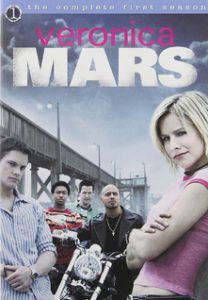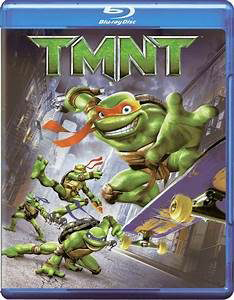After a 14-year absence from the big screen and probably a half-dozen near misses at a “TMNT IV” being made, the Turtles finally returned in 2007 with the lazily titled yet pretty darn good “TMNT.”The film, from writer-director Kevin Munroe and Imagi animation studio, is a continuation from the 1990s trilogy, but also a fresh start due to the animated approach.
Closer to the comics
There are things I wish it did differently, but 30 years after the Turtles’ invention, it’s clear we’ll never get a completely faithful Mirage-comics adaptation, and this movie will remain as close as we’ll get, with the exception of the Turtles Prime sequence in 2009’s “Turtles Forever.”
“TMNT’s” animation style – showcasing the Turtles running across rooftops and swinging through New York City on phone lines and clotheslines, followed by “Spider-Man”-esque virtual cameras – is a pleasing mix of “Star Wars: The Clone Wars” and newer Disney movies.

The Turtles look great, and Splinter, April and Casey are decent. I would’ve happily followed the franchise down this animated road, but – perhaps because of low box-office returns – this ended up being the last film of the original movie saga.
Another bland villain
Most likely, the public wasn’t quite ready for a major Turtles return in 2007, but “TMNT” doesn’t do itself any favors by failing to use villains – with the exception of Karai – from the comics, making this the third-straight sequel where the franchise balked at using the “Batman”-style rogues gallery approach. Instead of the Rat King or Leatherhead or Baxter Stockman or Triceratons, we get a generic corporate tycoon named Winters (voiced by Patrick Stewart), 13 generic intergalactic monsters and a bunch of generic ancient stone beasties.
While the voice cast is stellar — including Sarah Michelle Gellar as April, “The Clone Wars’ ” James Arnold Taylor as Leonardo and Laurence Fishburne narrating an introduction – casting the actors from the previous movies would’ve been better.
Hearing Paige Turco as April and Corey Feldman as Donatello would’ve been awesome, and this movie could use an audio anchor to the original three films due to being so visually different (this film’s camera moves and action scenes would be impossible in live-action).
Also, the music is a bit video-gamey; it’s a step up from the first two sequels, which don’t have memorable orchestral scores, but the repetitive action music draws attention to “TMNT’s” made-in-an-animation-lab sterility compared to the organic 1990 original.
Good Turtle development
The villains may not do the trick for me – although I do like the fact that Karai and the Foot end up on the Turtles’ side, similar to “City at War” — but the character stuff with the good guys is a huge step up from the previous two films.

Back in the day, when comic readers were itching for a Leo-vs.-Raph throwdown, Eastman and Laird delivered in “Return to New York” when Raph throws Leo through a farmhouse wall and storms off to New York. Now the film franchise delivers with a rainy rooftop fight where it seems the animators put in extra effort. There’s one shot of Leo staring down Raph in the rain that looks almost photo-real.
Munroe’s attempt to understand Leo is the most admirable part of the script because – despite the fact that he’s the leader – he’s the hardest Turtle to write for.
If you ask someone who their favorite Turtle is and they say “Raph,” “Don” or “Mike,” there’s no need to probe further; it’s understood that they relate to the moody one, the quiet one or the happy-go-lucky one. But if someone says “Leo,” it requires further questioning to make sure they’re not some kind of authoritarian jerk.
In “TMNT,” Leo – saying he opposes vigilantism — aims to stop Raph from being the Nightwatcher, even though what the Nightwatcher does (seeking out criminals and tying them up in a neat package for the police) is exactly what the Turtles have always done, going back to their rescue of April and apprehension of the muggers in the opening of the first movie.
But when Leo is captured after Raph beats him in the fight, we – and Raph — begin to see where Leo is coming from: With the team split up, they are less than the sum of their parts.
Finding their purpose
Springboarding from “TMNT III’s” theme of wanting a place to belong, the fourth movie – set somewhere between two and 10 years later, I’m guessing – shows us that the Turtles have made the best of the fact that they have to hide their true identities.
Mike is a birthday-party clown (he gets beat up by kids who assume he’s wearing a padded suit) and Don does tech support by phone; finally, we see the Turtles making a bit of money (although how they paid for living expenses – namely pizza — in the 15 years before they met April remains a mystery). Raph, meanwhile, is the Nightwatcher, and Leo is in the jungles of South America on some sort of spiritual quest that will make him a better leader.
While all of this flows logically from the last time we saw the gang, “TMNT” has two unexplained story jumps from the previous film. For one, the Turtles are in a new sewer lair; a simple line of dialog referencing when and why they departed the subway lair would’ve been nice.
For another, April is no longer a reporter; instead, she seems to specialize in shipping ancient artifacts from South America to wealthy magnates like Winters.
And more notably, she now possesses substantial martial arts skills, a far cry from “TMNT III,” where she’s headstrong but certainly not a physical fighter. I feel like this character point could’ve been earned with scenes of April training with Leo, especially since the film opens with April searching for Leo at the ends of the Earth, suggesting they have formed a deeper bond between the third and fourth films.
April and Casey
On the plus side, April and Casey’s status as live-in girlfriend and boyfriend is finally cleared up here, making up for the bungling of the previous two films.
Things seem to be going great at the end of the first movie, but could that just have been because of the sizzling chemistry between Judith Hoag and Elias Koteas? Since Casey goes unmentioned in “TMNT II,” one might assume it’s just a one-movie fling.
“TMNT III” features both April and Casey, yet it only adds to the confusion because Casey shows little concern over April’s disappearance and April seems peeved by Casey-lookalike Whit. At the end, Casey and April share a laugh as the Turtles goof around, but it’s unclear whether they are a couple. So the simple fact that “TMNT” clarifies matters is a big point in its favor.
Best of the sequels
The No. 1 point in “TMNT’s” favor, though, is that it takes the Turtles as seriously as the first movie does. Gone are the constant one-liners that define the first two sequels. Indeed, when Winters falls to the ground in the climactic scene, Mike says “Winters? More like Fall. Get it?” and Don says “Mikey, remember our talk.”
That’s not to say “TMNT” is deadly serious like the first Mirage comic issue. There is a nice sense of interplay between the brothers, with Mike of course providing the comic relief, at one point complimenting a meal with a loud belch. But, while “TMNT” understands that kids will be in the audience, it also respects adult viewers, and as such, the jokes don’t hijack the whole movie.
I would’ve welcomed more TMNT movies in this style – or even better, a TV series. (One year later, “The Clone Wars” proved that this level of animation was achievable on a weekly series.) The script even leaves the door open for more Imagi sequels, with Karai’s hint that the Shredder would return.
Perhaps Munroe planned to explore the worm-Shredder of “Return to New York” in future movies and eventually delve into the rogues gallery. As it turns out, it’s one-and-done for Munroe and Imagi’s take on the Turtles. That’s too bad, because outside of the Mirage/Image comics and the 1990 movie, it doesn’t get any better than this.

